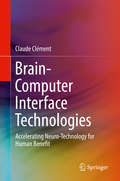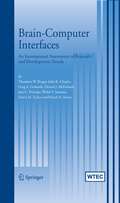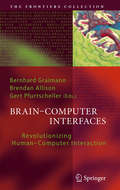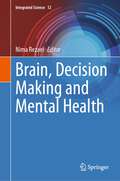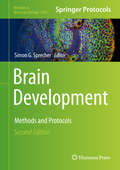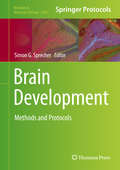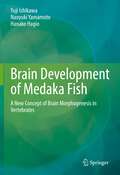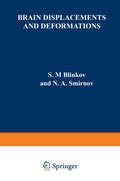- Table View
- List View
Brain-Computer Interface Technologies: Accelerating Neuro-Technology for Human Benefit
by Claude ClémentThis book is about the field of brain-computer interfaces (BCI) and the unique and special environment of active implants that electrically interface with the brain, spinal cord, peripheral nerves, and organs. At the heart of the book is the matter of repairing and rehabilitating patients suffering from severe neurologic impairments, from paralysis to movement disorders and epilepsy, that often requires an invasive solution based on an implanted device. Past achievements, current work, and future perspectives of BCI and other interactions between medical devices and the human nervous system are described in detail from a pragmatic point of view.Reviews the Active Implantable Medical Devices (AIMDs) industry and how it is moving from cardiac to neuro applicationsClear, easy to read, presentation of the field of neuro-technologies for human benefitProvides easy to understand explanations about the technical limitations, the physics of implants in the human body, and realistic long terms perspectives
Brain-Computer Interfaces: An international assessment of research and development trends
by Theodore W. Berger John K. Chapin Greg A. Gerhardt Dennis J. McFarland Jose C. Principe Walid V. Soussou Dawn M. Taylor Patrick A. TrescoWe have come to know that our ability to survive and grow as a nation to a very large degree depends upon our scientific progress. Moreover, it is not enough simply to keep 1 abreast of the rest of the world in scientific matters. We must maintain our leadership. President Harry Truman spoke those words in 1950, in the aftermath of World War II and in the midst of the Cold War. Indeed, the scientific and engineering leadership of the United States and its allies in the twentieth century played key roles in the successful outcomes of both World War II and the Cold War, sparing the world the twin horrors of fascism and totalitarian communism, and fueling the economic prosperity that followed. Today, as the United States and its allies once again find themselves at war, President Truman’s words ring as true as they did a half-century ago. The goal set out in the Truman Administration of maintaining leadership in science has remained the policy of the U. S. Government to this day: Dr. John Marburger, the Director of the Office of Science and Technology (OSTP) in the Executive Office of the President, made remarks to that effect during his 2 confirmation hearings in October 2001. The United States needs metrics for measuring its success in meeting this goal of maintaining leadership in science and technology. That is one of the reasons that the National Science Foundation (NSF) and many other agencies of the U. S.
Brain-Computer Interfaces: Revolutionizing Human-Computer Interaction (The Frontiers Collection #6)
by Bernhard Graimann Gert Pfurtscheller Brendan AllisonA brain-computer interface (BCI) establishes a direct output channel between the human brain and external devices. BCIs infer user intent via direct measures of brain activity and thus enable communication and control without movement. This book, authored by experts in the field, provides an accessible introduction to the neurophysiological and signal-processing background required for BCI, presents state-of-the-art non-invasive and invasive approaches, gives an overview of current hardware and software solutions, and reviews the most interesting as well as new, emerging BCI applications. The book is intended not only for students and young researchers, but also for newcomers and other readers from diverse backgrounds keen to learn about this vital scientific endeavour.
Brain-Computer Interfaces: Current Trends and Applications (Intelligent Systems Reference Library #74)
by Aboul Ella Hassanien Ahmad Taher AzarThe success of a BCI system depends as much on the system itself as on the user’s ability to produce distinctive EEG activity. BCI systems can be divided into two groups according to the placement of the electrodes used to detect and measure neurons firing in the brain. These groups are: invasive systems, electrodes are inserted directly into the cortex are used for single cell or multi unit recording, and electrocorticography (EcoG), electrodes are placed on the surface of the cortex (or dura); noninvasive systems, they are placed on the scalp and use electroencephalography (EEG) or magnetoencephalography (MEG) to detect neuron activity.The book is basically divided into three parts. The first part of the book covers the basic concepts and overviews of Brain Computer Interface. The second part describes new theoretical developments of BCI systems. The third part covers views on real applications of BCI systems.
Brain-Computer Interfaces (Handbook of Clinical Neurology #Volume 168)
by Nick F. Ramsey José del R. MillánBrain-Computer Interfacing, Volume 168, not only gives readers a clear understanding of what BCI science is currently offering, but also describes future expectations for restoring lost brain function in patients. In-depth technological chapters are aimed at those interested in BCI technologies and the nature of brain signals, while more comprehensive summaries are provided in the more applied chapters. Readers will be able to grasp BCI concepts, understand what needs the technologies can meet, and provide an informed opinion on BCI science. - Explores how many different causes of disability have similar functional consequences (loss of mobility, communication etc.) - Addresses how BCI can be of use - Presents a multidisciplinary review of BCI technologies and the opportunities they provide for people in need of a new kind of prosthetic - Offers a comprehensive, multidisciplinary review of BCI for researchers in neuroscience and traumatic brain injury that is also ideal for clinicians in neurology and neurosurgery
Brain-Computer Interfaces: Principles and Practice
by Jonathan Wolpaw Elizabeth Winter WolpawA recognizable surge in the field of Brain Computer Interface (BCI) research and development has emerged in the past two decades. This book is intended to provide an introduction to and summary of essentially all major aspects of BCI research and development. Its goal is to be a comprehensive, balanced, and coordinated presentation of the field's key principles, current practice, and future prospects.
Brain Control: Developments in Therapy and Implications for Society
by D. LindenInterest in techniques to control the brain and thereby improve its function has surged, yet how realistic are these expectations and what are the ethical implications? This book reviews the main techniques of controlling brain processes for medical purposes, situating them within ethical and legal debates on autonomy and fairness.
Brain Control of Wakefulness and Sleep
by Mircea M. Steriade Robert W. McCarleyBrain Control of Wakefulness and Sleeping explores the history of efforts to understand the nature of waking and sleeping states from a biological point of view. This research represents the synthesis of the work of two individuals who have devoted their careers to investigating the mysterious states of the mind. This landmark book will interest the beginner scientist/researcher as well as the sleep clinician, with chapters on subjects including Neuronal Control of REM Sleep, Motor Systems and the Role of Active Forebrain, and Humoral Systems in Sleep Control. The authors explore the behavioral and physiological events of waking and sleep, analyzing the current realities and the future possibilities of unifying basic studies on anatomy and cellular psychology.
Brain Crosstalk in Puberty and Adolescence (Research and Perspectives in Endocrine Interactions #13)
by Jean-Pierre Bourguignon Jean-Claude Carel Yves ChristenThis volume provides the reader with a pathophysiological perspective on the role of CNS in puberty and adolescence, starting from genetic/molecular aspects, going through structural/imaging changes and leading to physical/behavioral characteristics. Therefore, renowned investigators involved in both animal and human research shared recent data as well as overall appraisal of relevant questions around CNS control of puberty and adolescence. No doubt that this volume will inspire those involved in either scientific research or clinical practice or both in the fascinating field of puberty and adolescence.
Brain CT Scans in Clinical Practice (In Clinical Practice)
by Usiakimi IgbaseimokumoThis updated second edition provides a concise and up-to-date guide to emergency brain CT scans. Revised illustrations and images are included to assist readers in understanding key concepts in a clear way. The use of brain CT scans by health care professionals is increasingly common and has been effective in the minimising of costs and the unnecessary transfer of traumatic brain injury patients. The book aims to give nurses, emergency room physicians, primary care physicians, and doctors the information and tools needed to examine CT scans and explain them to their patients. With this knowledge emergency physicians and trauma surgeons will be able to decide whether an injury is life threatening.
Brain CT Scans in Clinical Practice (In Clinical Practice Ser.)
by Usiakimi IgbaseimokumoAcross emergency rooms all over the world, thousands of patients are referred for brain CT scans daily. A radiologist often has to interpret the scan or a consultation has to be made to a neuros- geon to review the scan. Most of this happens late at night and is a signi?cant source of discontent. Thus having frontline phy- cians to be pro?cient in interpreting the emergency brain CT scan improves the ef?ciency of the whole pathway of care and is pot- tially life saving as time is of the essence for many patients with severe brain injury or stroke. Underlying all of the above and the primary reason for writing this book is because the skill required to determine an immediate life threatening abnormality in a brain CT scan is so basic and can be learned in a short time by people of various backgrounds and certainly by all physicians. ‘Indeed the emergency head CT scan is comparable to an electrocardiogram in usefulness and most de?nitely as easy to learn. ’ This book is therefore written for ca- givers the world over to demystify the emergency CT brain scan and to empower them to serve their patients better. It is obvious to me from the response from people I have had opportunity to teach this subject that not only is there a desire to learn this basic skill but also people learn it quickly and wonder why it has not been presented so simply before.
Brain Damage and Repair: From Molecular Research to Clinical Therapy
by T. Herdegen J. Delgado-GarciaThis book builds a novel bridge from molecular research to clinical therapy. This approach reveals the functional features of neurons and glia in the particular context of vulnerability and self-protection, intracellular properties and extracellular matrix. Arising from this platform, this volume unfolds the molecular and systemic processes underlying migration disorders, axonal injury, repair and regeneration.
The Brain-Dead Organ Donor: Pathophysiology and Management
by Dimitri Novitzky and David K C CooperAddressing all aspects of brain death and thoroughly detailing how a potential organ donor should be maintained to ensure maximum use of the organs and cells, The Brain-Dead Organ Donor: Pathophysiology and Management is a landmark addition to the literature. This first-of-its-kind, multidisciplinary volume will be of interest to a large section of the medical community. The first section of the book reviews the historical, medical, legal, and ethical aspects of brain death. That is followed by two chapters on the pathophysiology of brain death as investigated in small and large animal models. This includes a review of the many hormonal changes, including the neuroendocrine- adrenergic ‘storm’, that takes place during and following the induction of brain death, and how they impact metabolism. The next section of the book reviews various effects of brain death, namely its impact on thyroid function, the inflammatory response that develops, and those relating to innate immunity. The chapters relating to assessment and management of potential organ donors will be of interest to a very large group of transplant surgeons and physicians as well as critical care and neurocritical care physicians and nurses. Neurologists, endocrinologists, neurosurgeons, and pathologists will also be interested, especially in the more basic science sections on various aspects of brain-death and hormonal therapy. Organ procurement organizations and transplant coordinators worldwide will also be interested in this title. Other chapters will be of interest to medical historians, medico-legal experts, and ethicists.
Brain Death: A Reappraisal
by C. MachadoThis text provides an overview of the processes of brain death, exploring the concepts and historical approach of human death, clinical examinations of brain-dead patients, ancillary tests in coma and brain death, bioethical discussions of brain death and its relationship with some consciousness disturbances, and the legal considerations of human death. Unlike other, narrow-focus reference this book encompasses a wide spectrum of issues including medical, legal, bioethical and historical aspects.
Brain Death and Disorders of Consciousness (Advances in Experimental Medicine and Biology #550)
by D. AlanShewmon CalixtoMachadoAlthough some decades have passed, there are still worldwide controversies about a concept of human death on neurological grounds. There are also disagreements on the diagnostic criteria for brain death, whether clinical alone or clinical plus ancillary tests. Moreover, some scholars who were strong defenders of a brain-based standard of death are now favoring a circulatory-respiratory standard. The study of coma is extremely important because lesions of the brain are responsible for quality of life in patients or cause of death. The main goal of Brain Death and Disorders of Consciousness is to provide a suitable scientific platform to discuss all topics related to human death and coma.
Brain, Decision Making and Mental Health (Integrated Science #12)
by Nima RezaeiBrain, Decision Making, and Mental Health acknowledges that thinking is not a constant phenomenon but varies considerably across cultures. Critical thinking is particularly important in bridging thinking divisions and its applicability across sciences, particularly medical sciences. We see critical thinking as educable and the arts as means to achieve this purpose. We address the multidimensional relationship between thinking and health and related mechanisms. Thinking mainly affects emotion regulation and executive function; in other words, both mental and physical health are related as a function of thoughts. Considering the thinking‐feeling‐emotion regulation/executive function pathway, it would be reasonable to propose thinking capacities‐based interventions to impact emotion regulation and executive function, such as mindfulness and psychotherapy. We review decision-making taking place in integrated and social contexts and discuss the decision-making styles-decision outcomes relation. Finally, artificial thinking and intelligence prepare us for decision-making outside the human mind.
Brain Degeneration and Dementia in Sub-Saharan Africa
by Seggane Musisi Stanley JacobsonStemming from a 2012 conference entitled Brain Degenerations and Emerging Mental Health Challenges in Sub-Saharan Africa, this book is aimed at both the general practitioner interested in CNS disorders, and the specialist who would like to know more about CNS pathology in Africa. By employing a broad defi nition of what brain degeneration means, the authors are able to touch upon everything from dementias and CNS malignancy to traumatic brain injury and CNS infective processes.This book draws from and builds upon the original conference presentations, and incorporates the most up-to-date science behind brain degeneration as well as actual case reports. Each of the book’s six sections off er the reader a deeper understanding of brain degeneration as it exists in Sub-Saharan Africa.
Brain-Derived Neurotrophic Factor (Neuromethods #143)
by Carlos B. Duarte Enrico TongiorgiThis volume discusses the latest techniques and methodologies used in the neurotrophin field to study the physiology of the Brain-Derived Neurotrophic Factor (BDNF). The book provides the tools essential to any researcher that intends to explore the peculiar regulation of this neurotrophin from gene expression to its release and the signaling by TrkB receptors, as well as to study the neuronal responses to BDNF or the role of neurotrophin in various neurological diseases. In Neuromethods series style, chapters include the kind of detail and key advice from the specialists needed to get successful results in your laboratory.Cutting edge and comprehensive, Brain-Derived Neurotrophic Factor(BDNF) is a valuable resource for researchers who want to further study the diversity of physiological roles of this important growth factor.
Brain Development: Normal Processes and the Effects of Alcohol and Nicotine
by Michael W. MillerThis is the first book about both normal development of the nervous system and how early exposure to alcohol and nicotine interferes with this development. The developing nervous system is highly dynamic and vulnerable to genetic and epigenetic factors that can be additive or synergistic. Disruption of normal brain development leads to an array of developmental disorders. One of the most common of these is mental retardation, the prime cause of which is prenatal exposure to alcohol. As chapters in this book show, alcohol has direct effects on the developing neural system and it affects genetic regulation. Another common neurotoxin is nicotine, and it is discussed in this book for three reasons: (1) the number of adolescents who smoke cigarettes is rising in some populations; (2) prenatal exposure to nicotine affects neurotransmitter systems that are critical for normal brain development and cognition; and (3) prenatal exposure to nicotine is often accompanied by prenatal exposure to alcohol.LThe mature brain is the culmination of an orderly sequence of the basic ontogenetic processes--cell proliferation, migration, differentiation, and death. Neural stem cells and progenitors proliferate in discrete sites; then, young neurons migrate long distances to their residences where they form neural networks. During this sequence many immature cells die, presumably eliminating unsuitable or non-competitive cells. Each process is regulated by genetic and environmental factors. When this regulation goes awry, a dysmorphic and dysfunctional brain results. Though this can be tragic in clinical settings, in experimental contexts it provides keen insight into normal brain development.LThe book is divided into three parts. The first describes neural ontogeny in the normal brain. The second and third deal with the consequences of early exposure to alcohol and nicotine. Though there are similarities in the effects of these two toxins, there are also intriguing differences. The commonalities reflect the plasticity and resilience of the developing brain while the differences point to the targeted effects of the two toxins. Exploring these effects brings a richer appreciation of brain development. The book will be of interest to neuroscientists, developmental biologists, teratologists, pharmacologists, toxicologists, neurologists, neuropsychologists, and to their students and trainees.
Brain Development: Methods and Protocols (Methods in Molecular Biology #2047)
by Simon G. SprecherThis book provides a thorough introduction to widely used techniques for the study of the intersection between developmental biology and neuroscience, an exceptional area to address and investigate impacting biological questions. The fully updated volume examines cutting-edge techniques on a representative range of animals, including widely used genetic model systems, such as the fruit fly, zebra fish, chicken, and mouse, as well as non-canonical experimental systems opened up through the advent of genome editing. Written for the highly successful Methods in Molecular Biology series, chapters include introductions to their respective topics, lists of the necessary materials and reagents, step-by-step, readily reproducible laboratory protocols, and tips on troubleshooting and avoiding known pitfalls. Authoritative and up-to-date, Brain Development: Methods and Protocols, Second Edition is an ideal guide for researchers interested in utilizing recent technical advances in molecular genetics for the study of the brain.
Brain Development: Methods and Protocols (Methods in Molecular Biology #1082)
by Simon G SprecherProviding widely used techniques in genetic model systems and many complementing animal models, Brain Development: Methods and Protocols focuses its expert contributions on two key technical aspects of developmental neurobiology: detection of gene expression and functional characterization of developmental control genes. Covering animal models such as the fruit fly, zebra fish, chicken, and mouse, this detailed book views in situ hybridization, reporter gene expression, and immunohistochemical staining methods, as well as RNA interference, Morpholino, or transgenic techniques through the prism of these models. Written in the highly successful Methods in Molecular Biology series format, chapter include introductions to their respective topics, lists of the necessary materials and reagents, step-by-step, readily reproducible laboratory protocols, and tips on troubleshooting and avoiding known pitfalls. Practical and cutting-edge, Brain Development: Methods and Protocols aims to provide precise technical protocols but also allows for comparing a wide range of protocols in different tissues and species.
Brain Development in Drosophila melanogaster (Advances in Experimental Medicine and Biology #628)
by Gerhard Martin TechnauBrain Development of Medaka Fish: A New Concept of Brain Morphogenesis in Vertebrates
by Yuji Ishikawa Naoyuki Yamamoto Hanako HagioThis book describes the developmental process of the brain of the medaka fish. It aims to understand the brain structure of vertebrates, including humans, by taking the brain of the medaka fish as an example and showing its actual developmental process. From developmental and evolutionary viewpoints, the understanding of the brain proceeds from simple to complex structures. Fish retain the basic form of vertebrates, and their brain morphology is relatively simple. Therefore, the fish brain is useful in understanding the brain structure. This book is unique for describing the entire process of the brain development in a specific fish. In addition, the book introduces the readers to a new concept of “Hourglass of Brain Morphogenesis”, concerning the general rule of brain morphogenesis in vertebrates. The authors propose that the brain morphology is highly conserved at the middle developmental stage but diverges more extensively at earlier and later stages. The new concept challenges the accepted theory that has been widely shared for about 200 years since K. von Baer (1828, 1837) and K. von Kupffer (1906) who proposed that three primary brain vesicles at earlier developmental stages develop into five secondary brain vesicles at later developmental stages in all vertebrates. The book provides a basic understanding of the vertebrate brain and is useful for all readers who wish to understand the complex structure of the brain.
Brain Displacements and Deformations
by S. M. BlinkovIn writing our book we had in mind both practicing physicians and scientif ic personnel. We hope that the former will benefit from an analysis of clinical symptoms and changes in the morphological substrate which produce them, and that the latter will be interested in facts illustrating the resistance of nervous tissue to compression and displacement, and in our concept of the primary role played by blood supply in the functional disturbances of a deformed brain stem. Although only a short time has elapsed since the first edition of the book, it has been necessary to introduce a number of addenda and corrections into the present edition. The chapter "Roentgenological Manifestations of Brain Displacements," written by N. S. Plevako and Z. N. Polyanker, has also been expanded. We are glad that a competent publishing house such as Plenum Press has undertaken the American publication of the book; we offer our sincere thanks to Mr. George Onischenko for his excellent translation; and we express our gratitude to Mezhdunarodnaya Kniga, the Soviet Book Export Agency, in the person of Galina Aleksandrovna Khudozhnikova, for their cooperation.
